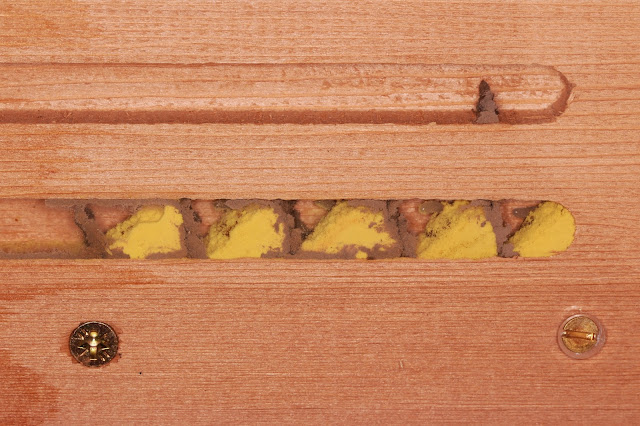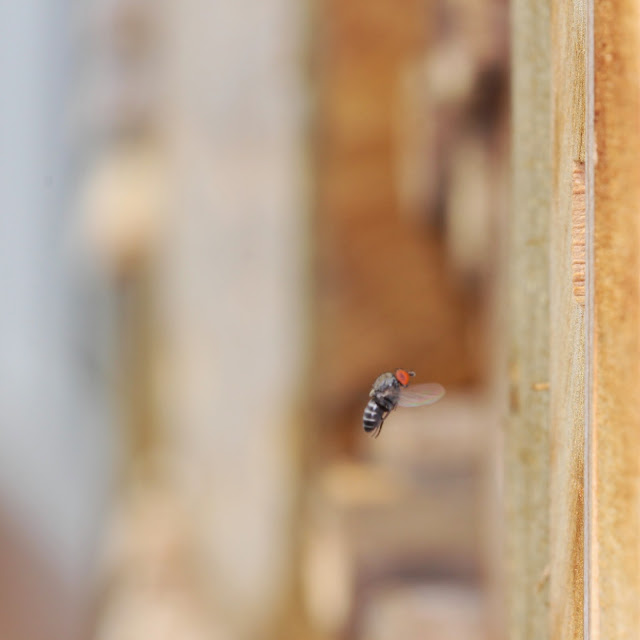At last, after what seemed a very long wait, the sun shone and the female red mason bees emerged. The males were presumably very relieved as some of them had been hanging around for nearly four weeks. The females set about foraging, being especially fond of some winter broccoli plants I had left to run to flower. They are a little smaller than a worker honey bee.
The males have been patrolling the flowers for weeks, occasionally pausing to refuel with nectar. The males are smaller than the females and have white hairs on their faces and longer antennae.
I wrote previously about the bee house I had put up in the hope that the red mason bees might move in.
This piece on the side has a series of 8 mm square grooves with a perspex window to allow observation. The side is normally closed to keep it dark inside.
To my delight three bees moved in, although one stayed only one night and didn't return. This one is peering out from her chosen home in the observation wing.
Here are neighbours in adjacent holes in the observation wing.
Red mason bees are so called because they use mud to build walls between the cells in the nest. Here is the female returning with a mouthful of wet mud.
And here she is bringing in a load of yellow pollen on her scopa (the pollen-carrying hairs underneath her abdomen).
The size of the cell is first marked out with mud (above) and the base of the wall is built before the first load of pollen is delivered (below). Sadly the bee in the upper hole didn't return.
The cell is nearly filled with pollen before she lays an egg on top and then completes the wall.
Here the bee is delivering another load of mud and then closing up the wall. I didn't take many photos while the side of the observation wing was open as I didn't want to disturb her.
Next she marked out the size of the second cell and repeated the process. I am very impressed by the precision of the work.
Here the second cell is complete and the third is under construction.
Then there were four
and five
and six
Here she is resting (bottom left) after starting work on the seventh cell. She stays in overnight to guard the nest and to stay safe and warm. It is interesting that all the pollen is the same colour, so all from the same source.
The bee lays female eggs first and males last - they are at the front of the nest and so will emerge first next spring. Once the eggs hatch the larvae will eat the pollen before spinning a cocoon and turning into pupae. The mature bees develop in their cocoons but remain in their cells over winter.
Here the female is leaving to collect more pollen or mud.
When her back was turned a Cacoxenus indagator came to investigate the nest. It is a tiny parasitic fly looking to lay its own eggs in the nest.
Another red mason bee set up home in one of the hollow bamboo canes. She had holes of many different sizes to choose from but chose an 8mm hole. This photo shows well the two horns on her face which are used to work the mud, hence the name Osmia bicornis.
It is interesting that both she and the bee in the observation hole can turn around in their nest holes so they always enter and leave head first. They have to turn around to scrape off the pollen load into the cell or to lay an egg.
She has now filled her nest hole and sealed it with mud. It must take less mud to build walls in an 8mm round hole than an 8mm square hole so she has finished more quickly. I don't know if she has now finished completely or has moved to another hole.
There are other bees flying around and some have chosen holes in the wall, like last year. These are old screw holes where there was once a trellis and I think the holes are probably 7mm or perhaps 6mm in diameter. This bee is resting inside the hole, lying on her back.
She always enters head first.
She then emerges backwards and if she has been delivering mud she flies off to collect another load.
However, if she was carrying pollen she goes in head first and after a few seconds comes out backwards, turns around, reverses into the hole, delivers the pollen and then re-emerges head first.
I have been completely fascinated watching these bees over the past few days and I am very pleased that one of them chose the observation wing so I could see what is going on. I'll post an update once the laying is complete and as the eggs hatch and the larvae develop. I'll also keep my fingers crossed and hope for some leaf-cutter bees in a few weeks' time.


















































